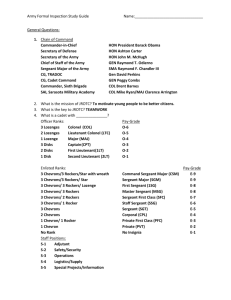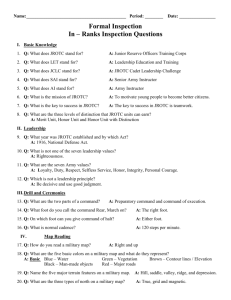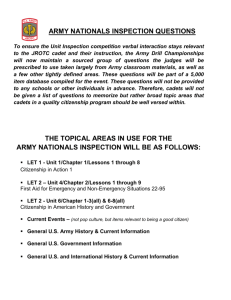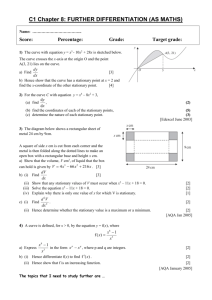JPA Quiz Study Guide - Sarasota Military Academy
advertisement
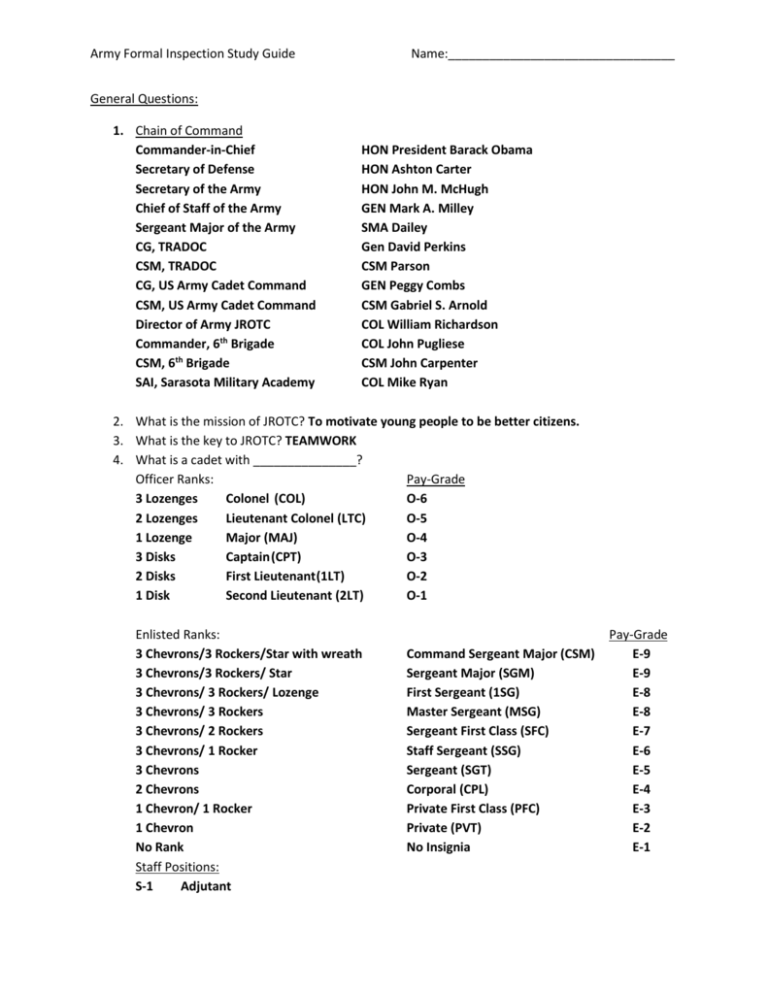
Army Formal Inspection Study Guide Name:_________________________________ General Questions: 1. Chain of Command Commander-in-Chief Secretary of Defense Secretary of the Army Chief of Staff of the Army Sergeant Major of the Army CG, TRADOC CSM, TRADOC CG, US Army Cadet Command CSM, US Army Cadet Command Director of Army JROTC Commander, 6th Brigade CSM, 6th Brigade SAI, Sarasota Military Academy HON President Barack Obama HON Ashton Carter HON John M. McHugh GEN Mark A. Milley SMA Dailey Gen David Perkins CSM Parson GEN Peggy Combs CSM Gabriel S. Arnold COL William Richardson COL John Pugliese CSM John Carpenter COL Mike Ryan 2. What is the mission of JROTC? To motivate young people to be better citizens. 3. What is the key to JROTC? TEAMWORK 4. What is a cadet with _______________? Officer Ranks: Pay-Grade 3 Lozenges Colonel (COL) O-6 2 Lozenges Lieutenant Colonel (LTC) O-5 1 Lozenge Major (MAJ) O-4 3 Disks Captain (CPT) O-3 2 Disks First Lieutenant (1LT) O-2 1 Disk Second Lieutenant (2LT) O-1 Enlisted Ranks: 3 Chevrons/3 Rockers/Star with wreath 3 Chevrons/3 Rockers/ Star 3 Chevrons/ 3 Rockers/ Lozenge 3 Chevrons/ 3 Rockers 3 Chevrons/ 2 Rockers 3 Chevrons/ 1 Rocker 3 Chevrons 2 Chevrons 1 Chevron/ 1 Rocker 1 Chevron No Rank Staff Positions: S-1 Adjutant Command Sergeant Major (CSM) Sergeant Major (SGM) First Sergeant (1SG) Master Sergeant (MSG) Sergeant First Class (SFC) Staff Sergeant (SSG) Sergeant (SGT) Corporal (CPL) Private First Class (PFC) Private (PVT) No Insignia Pay-Grade E-9 E-9 E-8 E-8 E-7 E-6 E-5 E-4 E-3 E-2 E-1 Army Formal Inspection Study Guide Name:_________________________________ S-2 Safety/Security S-3 Operations S-4 Logistics/Supply S-5 Special Projects/Information U.S. Military History: 5. Who were the primary antagonists during WWII (who did the US and its allies fight?) Germany, Japan, and Italy 6. What happened on 7 December 1941 in Hawaii? The Japanese attacked Pearl Harbor 7. Who was the Commander of the Revolutionary Army? General George Washington 8. What war was fought in the 1960’s and 1970’s? The Vietnam War 9. What happened in New York City and Washington DC on 11 September 2001? Terrorists attacked the World Trade Center, pentagon, and Shanksville Pennsylvania. 10. Which country did the US attack initially on the war on Terrorism? Afghanistan 11. What military operation was initiated on 21 March 2003? Operation Iraqi Freedom Classroom Management: 12. What tools are being used in the classroom to assist in the presentation of the curriculum? Classroom Performance System (CPS) 13. What are the steps to the four phase lesson plan? Inquire, Gather, Process, and apply 14. Identify two thinking maps? Brace map, Bridge map, bubble map, circle map, double bubble map, flow map, multi-flow map, and tree map Citizenship and Constitution Q: What are the first 10 Amendments to the U.S. Constitution known as? The Bill of Rights Q: Which amendment grants the “freedom Of Speech”? The First Amendment Q: What age is a U.S. Citizen allowed to vote? 18 years old Q: What are the two primary political parties? The Republican party and the Democrat party Army Formal Inspection Study Guide Name:_________________________________ First Aid: Q: What is the Heimlich Maneuver used for? A: To clear a blocked airway. Q: What is First Aid? A: The assistance someone provides to an injured person until trained medical personnel arrive. Q: What is mouth-to-mouth resuscitation used for? A: To restore breathing Map Reading: Q: What are the five basic colors found on a military map and what do they represent? A: Blue Green Brown Black Red Water Vegetation Contour, Elevation and Relief Manmade Objects Other Manmade Objects and Densely Populated areas Q: What instrument would you use to determine a magnetic azimuth in a field environment? A: Compass Q: What instrument is used to determine grid azimuth on a map? A: Protractor Q: What are the five major terrain features? A: Hilltop, Ridgeline, Saddle, Valley, Depression Winning Colors: What are the four winning colors and what do they represent? Brown Builder Red Adventure Blue Relater Green Planner Army Formal Inspection Study Guide Name:_________________________________ 15. What are the winning colors used for? To determine strengths and potential weaknesses and how to conduct meetings and capitalize and strengths and weaknesses of individuals in group planning. JROTC Uniform Knowledge Q: What color socks are worn with the class A or B uniform? A: Black socks. Q: What type of shirt is worn under the Army Class A Jacket? A: Class B long sleeve shirt or short sleeve shirt. Q: The black necktie/neck tab is optional when wearing what type of uniform? A: Class B uniform with short sleeves. Q: What color t-shirt is worn with the class A or B uniform? A: White. Q: What uniform is worn during ceremonies and social functions? A: The Class A or B uniform. Q: What uniform is worn at summer camps and for participation on special teams? A: ACUs. Q: What insignia do cadet officers wear on the garrison cap/Beret? A: rank insignia. Q: What insignia do enlisted NCO cadets wear on the garrison cap/Beret? A: ROTC insignia. Q: What color t-shirt is worn with the ACU uniform? A: Tan. Q: How is the grade (or ROTC) insignia worn on the Beret? A: Centered in the middle of flash or beret Q: How is the JROTC Rank insignia worn on the class A uniform? A: Officer: 5/8 inch from seam, ¼ in between Disks and Lozenge A: Centered between bottom of button and shoulder seam Q: Where is the Honor Unit insignia worn? A: Males: ¼ of an inch and centered above the top of the right pocket A: Female: ¼ inch and centered above the nameplate Q: How are ribbons positioned on the class A or B uniform? Army Formal Inspection Study Guide Name:_________________________________ A: Ribbons are centered on the left side 1/8 of an inch above the left pocket (centered above the horizontal line for female cadets). Q: Describe a rank? A: Name of Rank Q: How many ribbons are required to complete a full row. A: 3 Ribbons Q: Can a male cadet wear an earring in uniform? A: NO. Q: What size earrings can female cadets wear? A: Small spherical earrings not to exceed 1/4 inch in diameter. Q: How should the nameplate is worn on your uniform? A: Male: Center the nameplate on the right pocket between the top of pocket and the top of the button for males. A: Female: Aligned and centered from the top of the 2nd button from the collar. Q: How is the Beret worn? A: 1 inch above eyebrows and straight across forehead. Center the flash above the left eye. Pull excess material between the top and middle of right ear. Q: How are Special team badges worn? A: Male: Centered between bottom of pocket and bottom of pocket flap. If more than one, they are 1/8” apart below name tag. A: Centered 1/8 inch below nametag Q: What Colored Watches are authorized With the Class A and B uniform? A: Black, Gold, Silver Q: What does ACU stand for? A: Army Combat Uniform. Army Formal Inspection Study Guide Name:_________________________________ Drill Knowledge Marching Commands – command is called Fall In - stationary Dress Right Dress - Stationary Ready Front - Stationary Parade Rest - Stationary At ease - Stationary Rest - Stationary (Group) Attention - Stationary Present Arms - Stationary Order Arms - Stationary Left Face - Stationary Right Face - Stationary Cover - Stationary Recover - Stationary Forward March – Stationary, then step off with left foot Column Right March – Given on right foot Column Left March – Given on left foot Rear March – Given on right foot Right Flank March – Given on right foot Left Flank March – Given on left foot Counter Column March – Given on left foot Mark Time March – Either foot (Group) Halt – Either Foot Fall Out - Stationary File from the Right/Left March - Stationary File From The Right/Left Column Right/Left March - Stationary Column # to the Right/Left March - Stationary Q: What act of Congress established JROTC? A: National Defense Act of 1916 Q: When do you salute? A: When you recognize someone who is authorized a salute A: When in uniform and “Hail to the Chief” of the “National Anthem,” or “To the Colors” is played A: When in uniform and the National Colors pass by you. You salute 6 steps prior to the colors getting to you, and hold your salute until the colors are 6 steps passed you. A: When in uniform at reveille (the raising of the flag) and retreat. (The lowering of the flag). A: When reporting to an officer A: When in doubt, salute! Army Formal Inspection Study Guide Name:_________________________________ Q: Who do you salute? A: All Officers and Warrant Officers of the Armed Forces and ROTC Q: When do you NOT salute? A: When at work A: Indoors, except when reporting A: When both hands are full A: When it is obviously inappropriate Q: In drill, what are the five Stationary positions? A: Parade rest, stand at ease , at ease, rest, and Attention Q: When marching, at a quick time, what is the normal arm swing distance? A: 9 inches to the front and 6 inches to the rear Q: Which command is used to cancel a preparatory Command? A: As You Were Q: Drill commands are given on what position? A: Attention Q: How many inches are in a normal marching step? A: 30 inches Q: Which foot can you give the command of halt on? A: Either foot Q: What position are you allowed to speak at while information? A: Rest Army Formal Inspection Study Guide Name:_________________________________ General Knowledge Q: What is the definition of leadership? A: Leadership is the art of influencing someone to complete the mission in a desired manner by providing purpose, motivation and direction. Q: What does JROTC stand for? A: Junior Reserve Officer Training Corps Q: Where does the word “Corps” comes from and what does it stand for? A: The French word meaning Body to refer to a military unit. Q: What is the birth date of the United States Army? A: 14 June 1775 Q: When did the Continental Congress establish the stars and stripes as the flag of the U.S? A: 14 June 1777 Q: What is the Bill of Rights? A: The first ten amendments to the U.S. Constitution. Q: What is the highest military award for a member of the Armed Forces? A: The Medal of Honor Q: Who wrote the JROTC Cadet Creed? A: SGM Calvin Foster Q: How many steps are there in folder the flag? A: 13 Q: What are the types of flags used by the military? A: The garrison Flag, 20 x 38 feet, Post Flag, 10 x 19 feet, and Storm Flag 5 x 9’1/2 feet Q: What is the difference between a Standard and a Color? A: Colors are flags of ORGANIZATIONS and standards are the same thing, except they are mounted on vehicles. Q: When may the U. S. Flag be flown upside down? A: To signal an emergency of distress Q: What does Red, White, and Blue stand for on the US Flag? Army Formal Inspection Study Guide Name:_________________________________ A: White signifies purity and innocence, Red, hardiness & valor, and Blue, signifies vigilance, perseverance & justice
